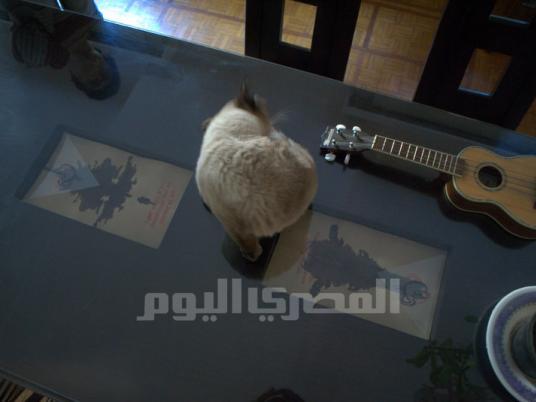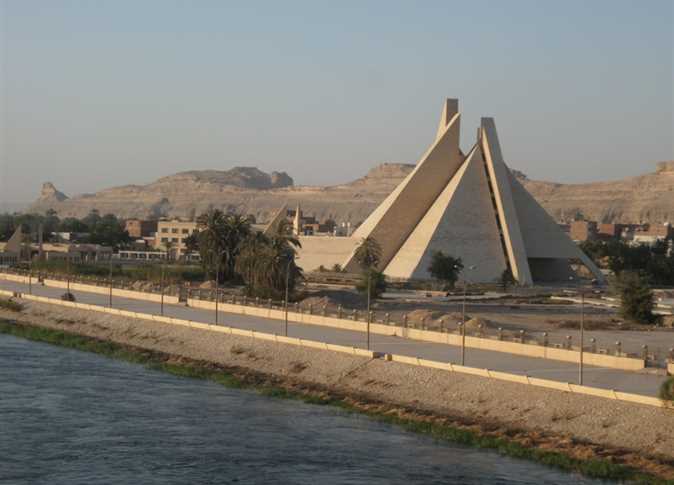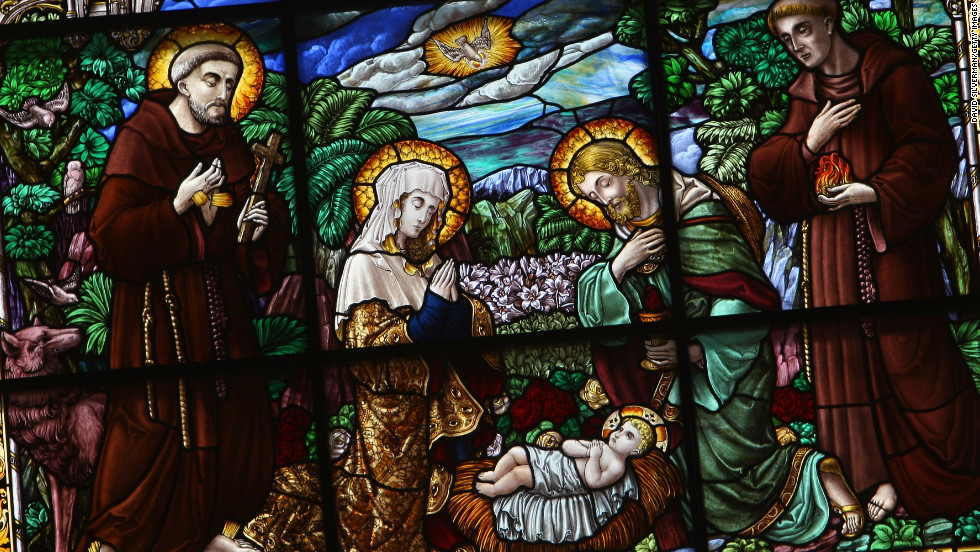
A “museum” has been set up by an international group of four people — one of whom is Egypt Independent’s Helen Stuhr-Rommereim — in two small rectangular recesses under a glass tabletop in a Garden City apartment.
“Every month, an artist is invited to show her or his artwork in the two empty display boxes carved in our living-room table. The artist chooses what and how to exhibit. We live with it for thirty days. The table remains a table with all its regular functions. Every month opens with a dinner with the artist and his or her guests,” says The Table Museum blog.
When I heard about it I thought of “convivial” artworks like Allen Ruppersberg’s diner, Al’s Cafe, where he sold dishes that often combined something edible with something else, like “small dish of pine cones with cookie.” I also wondered if the Table Museum was intended to become a monthly art salon.
In fact, it is simpler and quieter than that, at least in its nascent stage, but it shares with its precedents an interest in getting away from conventional art spaces and in hanging out. The dinner opening was like a normal gathering of friends, with the added benefit of art to look at.
The four founders, two of whom are artists, chose the term “museum” to play with the audience’s expectations, but the project seems to be investigating the idea of the gallery more than the museum. It is presented as an alternative art space, and its founders seem more curious to see what will happen than drive the project in a particular direction. They are curious about how artists will respond to the restrictions of the space, and about the personal relationship between the four of them, the artist and the work. After each show, they will hold a feedback session to tell the artist what it was like to live with their art.
Although the general public can make appointments, the museum seems set up less for a live audience than as blog content. Their blog will be regularly updated with photos and texts on the experience of living with the work.
Egyptian-American artist Hady Kamar is the first artist to show at the Table Museum, and has made two screen prints specially for it with a four-color press that he recently built. The prints lie at the bottom of the table’s two recesses, the paper bubbling up a little. They each bear a red slogan and a diagram of a stomach, printed on top of a black Rorschach ink blot. The slogans read: “Most of the day I just feel so damn empty inside” and “I get upset a lot. Sometimes for no reason at all.” On each buckled print lies a transparent plastic triangle with the same stomach diagram on it: “A really nice, well-printed transparency on top of this roughness,” Kamar says, to emphasize the “contrast of how it should be versus how it turned out.”
“I’m interested in how bodies deal with mental issues or problems, it just so happens that I physically respond, my stomach in particular,” he explains. The prints are the first in a series that will deal with various problematic body parts, the suffering of which he attributes in part to being far from loved ones or feeling caught between multiple places.
The prints are intimate, a response to the personal nature of the Table Museum, and to the semi-permanent lifestyle of his audience of four. He says it is an attempt to open a dialogue with his body, but also a conversation with the audience about how they each deal with physically manifested psychological problems when they are far from home. He also wants the stomach imagery to make those living in the house “think about what they’re eating, what their bodies are doing” while they eat.
Kamar says it is refreshing to make something so personal — “about my bowel movements” — at a time when current events have been at the fore in everyone’s minds and work, and a lot of his own work has been about exterior things. However, the prints do have a revolutionary look. The stark red and black on cheap brown packaging paper Kamar bought for the purposes of revolution-related graffiti are reminiscent of Soviet propaganda posters of the 1920s. His more introspective work might not be totally separable from the political, but he says that with this series he is relishing “making a mess, looking for errors, enjoying the errors.”
Artists’ museums
Small museums set up by artists have become a sort of genre, perhaps since Marcel Duchamp began creating his retrospectives in suitcases in 1935. They are often characterized by deadpan humor, a sense of anger and portability. In January, I went to see an exhibition about artists’ museums at the Arnolfini, a UK gallery, full of one-artist outfits appropriating the label or structure of “museum” for their own, often political, ends.
One was Khalil Rabah’s Palestinian Museum of Natural History and Humankind, which exists when different aspects of it — such as its storage area, its newsletter, or vitrines of handcrafted fossils — are exhibited in international venues. It is an absurd fiction, which points out in great detail what reality lacks.
Another piece was Museo Salinas, a museum in artist Vicente Razo’s bathroom dedicated to a collection of strange angry trinkets caricaturing former Mexican President Carlos Salinas de Gortari. Razo hung a sign on the door and had business cards printed: “Vincente Razo, Museo Salinas Director.”
“The simple act of christening my toilet a museum had a magical effect. Everyone from artists to homemakers to bureaucrats and reporters, from all over the world, filed through the bathroom-museum,” he wrote, adding that his act was in part a response to museums being “immersed in a colonized and elitist agenda with an atrophied bureaucratic corps afraid of any fragment of reality they might be expected to represent.”
Also included was a version of Asuncion Molinos’ brilliant World Agriculture Museum, which was first shown in Cairo late 2010. It very convincingly appropriated the aesthetics of the Cairo Agriculture Museum while exposing the injustice of global agriculture systems.
The Table Museum is an initiative full of potential, especially exciting in a city with so few artist-run or alternative spaces. As Razo said, “Why seek out museums as an artist or wait for museums to seek you out when you can start up your own?”
It seems that invited artists will have a big say in the direction the space goes in and in what kinds of openings they have, perhaps making art that incorporates or competes with the food served and the people eating it. It suits the transient part of Cairo’s population, quickly set-up, easy to pack up and blog-based.
Hady Kamar’s exhibition at the Table Museum will be open until 19 February.




